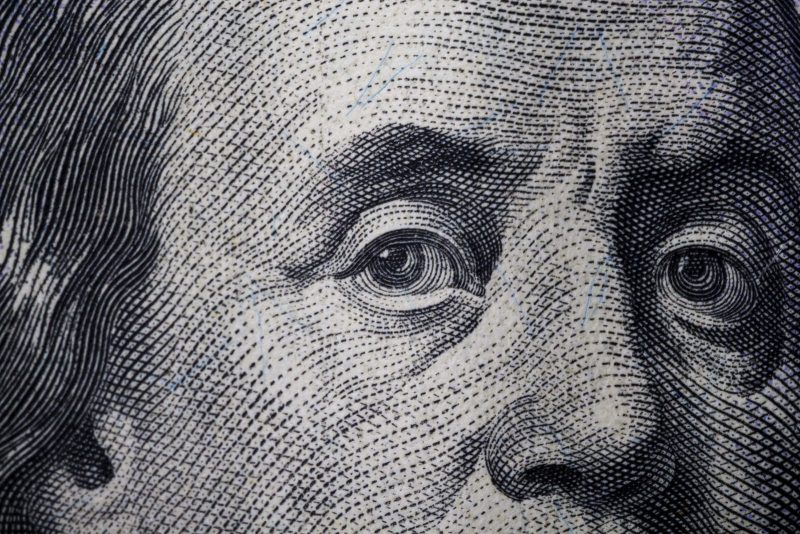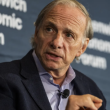by Hubert Marleau, Market Economist, Palos Management
A few days ago, Donald Trump told the Americans that “if we lost the dollar as the world currency…that would be the equivalent of losing a war”. Indeed, the U.S.’ reserve currency status does bring exorbitant privilege: First, it creates demand for dollars, thereby tending to reduce borrowing rates and keep them lower than they would otherwise be. Second, such reserves become important and very handy in fighting financial crises. Third, there is a big national security element, because a huge percentage of the global financial network essentially goes through U.S. regulators, gaining all kinds of information to ward off terrorist threats, alert intelligence services, and implement sanctions in place of military interventions. Fourth, net trade patterns are caused by financial flows, not the other way around, allowing consumers to spend more, and businesses to invest more, than they would be able to otherwise.
On this last point, the US has a structural trade deficit, while the EU has a structural trade surplus, yet the US invests a lot more, as a percentage of GDP, than the EU. In fact, a big amount of the US’s structural net inflow of capital is spent on R&D and data centers to train AI, which is what affords the U.S. to take big investment risk and keep its current innovative edge without reducing household consumption. America should be grateful that it can suck in the savings of others to fund what they envy so much. For example, Canada holds $2.6 trillion of US securities, contributing capital to American firms, holding down borrowing costs, and boosting the net worth of US households. According to Bloomberg, Canadian holdings are equivalent to more than 40 times the 2024 US goods trade deficit with its northern neighbour. It’s one of the many illustrations of how what may appear to some as a waste of money actually accrues to American interest.
Is the US Dollar Still Dominant? Yes
As it stands today, the dollar is the world’s leading currency because the U.S accounts for 26% of the global economy; remains about the same size as it was in the 1980s; is still the foremost military power; remains at the frontier of technological development, has the deepest, most diversified and liquid market financial market in the world; holds independent institutions that regulate its domestic markets; plus a central bank that acts as a lender of last resort in times of crisis for the rest of the world as a whole. These are the reasons why 58% of global reserves are in dollars, 81% of world trade is conducted in dollars, 48% of international bonds are denominated in dollars, and 47% of cross-border claims are set in dollars.
There is another area where the dollar leads the world as a currency. The US economy has been able to attract extraordinary amounts of foreign capital for decades, sucking the world dry of capital. The inflow of funds to the U.S. has been driven from destructive investment policies of the European Union, China’s closed economic model, and the uniquely attractive returns of the US as the global innovator. The sheer appetite for claims on the US has reshaped its external balance sheet. As a result, the U.S. net international investment position - the difference between US residents’ foreign financial assets ($35.89trn) and liabilities ($62.12trn) - was -$26.23 trillion at the end of 2014, representing about 85% of the N-GDP.
Based on the Federal Reserve trade-weighted index, which measures the dollar against the currencies of countries with which the U.S. trades most, the almighty dollar is 5 times more expensive today than it was in 1973, when the Middle-East oil producers hit the world with an oil shock.
Could Something Go Wrong? Yes
In 1971, President Nixon stopped the convertibility of dollars into gold, which led to a floating exchange rate system that was based on a theory that currency reserves would cease to be necessary because the free market price mechanism would make the necessary adjustments to keep the international balance of payments in an acceptance equilibrium. Nonetheless, the system has been subject to a plethora of crises since, notably the Asian crisis of the late 1990s, and the great financial crisis of 2008-09.
As US exceptionalism erodes gradually, and the damaging effects of Trump’s economic nationalism and protectionism grow, the dominant role of the US dollar in the world monetary order is being challenged by three candidates: the EU (euro), the BRICS (yuan), and the Underground Economy (cryptocurrencies). The bottom line here is that the dollar is fraying at the edges. The euro is growing its footprint, the renminbi is breaking free of the dollar, and crypto is ousting the dollar in the world's underground economy, where governments do not control things, or not much.
Progress has been limited. Nonetheless, a shift away from the dollar is ongoing. But this process could speed-up somewhat, because the Trump administration offers mixed signals. It wants the dollar to weaken against other major currencies, while retaining its status as the anchor of global finance. Scott Bessent, US Treasury Secretary, says the US wants a strong dollar policy, while Horward Lutnick, the Commerce Secretary, promotes the benefits of a weak dollar. Meanwhile, Stephen Miran, chair of the White House’s Council of Economic Advisers, talks about the burden of owning the reserve currency.
Trump’s erratic policies are giving the European Central Bank a prime opportunity to take steps to strengthen the euro’s international role. Its president, Christine Lagarde, is pushing this idea, as a global euro moment, because it would allow the EU currency bloc to enjoy the privileges so far reserved for the US. In this connection, she has urged the members of the European Monetary Union to maintain a steadfast commitment to open trade, underpinned with security capabilities; to complete a single market by trimming regulations; to build a savings and investment union; and to foster financings at the European level to fund large projects, including defence, thereby creating a deeper pool of securities and a larger bond market - prerequisites for a greater international role for the euro.
This year’s BRICS summit will focus on the creation of a multi-jurisdictional gold custody network, whose vaults are already under construction as the backbone of a new settlement system, where gold is the primary collateral asset, replacing the U.S. Treasury as the standard bearer of trust. Under the plan, gold would serve as the store of value, replacing US Treasuries, and the yuan as the medium of exchange, replacing the US dollar.
According to Kenneth Rogoff, from the IMF and Federal Reserve, who help shape the dollar-led global economic and monetary order, the growing influence of cryptocurrencies is chipping away at the greenback’s global standing. The underground economy already accounts for about 20% of the global GDP, according to World Bank literature. This is about people who pay in cash for amiable services like tips and home services, and for harmful ones like arms dealing, human trafficking, and drugs, plus tax evasion, which is quantitatively larger.
I've concluded that the world will slowly move toward a multi-currency power, with the dollar being less dominant than today, but still deeply entrenched. Keep in mind that it reigns in part because the US economy is huge- as big as China, Germany and Japan combined. Remember, too, that talk of the dollar’s demise in the 1990s at the hands of the Japanese yen, and in the 2000s by the euro, did not amount to much.
So What Went On Last Week, Ended May 30?
Over the Memorial weekend, in the blink of an eye, President Trump backed away from Friday’s threat to ramp up tariffs on imports from the European Union, because it had since agreed to fast-track trade talks. On Monday, bets on a rising dollar and lower bond yields loomed large, pushing stock futures up, and translating into a 2.1 % increase for the S&P 500 to 5922 on Tuesday, with the help of a significant improvement in the Conference Board’s consumer confidence index and of a predicted 2.2% growth in Q2 by the Atlanta Fed.
On Wednesday, the S&P 500 fell 0.6% to 5883 as the Fed pointed out in the minutes of the last FOMC meeting that there was a measurable risk of a recession, amid persistent inflation, and that the tariff rates would continue to cause uncertainties until the issue was resolved amicably. The word “uncertainty” came up 17 times. As a result, business investment saw its biggest drop in 6 months, as uncertainty stemming from trade wars was disrupting the supply chains, in spite of the fact that the hyperscalers like Microsoft, Amazon, Meta and Google all affirmed plans to boost their capex on ASI infrastructure to top $345 billion in 2025, up 40% from 2024.
On Thursday, in a blow to the White House’s economic agenda, the US Court of International Trade stated that Trump had overstepped the bounds of his executive authority. Specifically he had invoked the International Emergency Economic Powers Act of 1977, or IEEPA, which does not mention tariffs, to justify his levies. The decision applies to the flat 10% tariffs on trading partners, as well as the reciprocal tariffs and those tied to fentanyl enforcement against Canada, Mexico and China. Tariffs on steel and aluminum, imposed under a different authority, aren’t affected by the ruling. Wall Street traders cheered the decision, sparking sharp gains for equity futures before the official trading session started. Later in the day, however, the appeals court paused the ruling, and the rally faded. Nonetheless, the S&P 500 hung on to close up 0.4% to 5912.
On Friday, traders expected that Trump & company were likely to find other avenues to keep his tariff policies intact and feared that the truce between China and the U.S. was at risk of falling apart. Given the sensitivities of investors the S&P 500 did better than one would have conjectured, nudging only 0.01%, basically unchanged at 5912.
The Near-Term Stock Market Outlook
Last week, I wrote: “I still have a 6000 target for the S&P 500 for 2025. Interestingly, flying in the face of menacing vigilantes, several market strategists are revising upward their S&P 500 targets, and seem to be taking a longer view than they usually do. For example, Morgan Stanley, including its chief economist, has turned very constructive on US stocks, predicting that the S&P 500 will reach 6500 by the end of the 2nd quarter of 2026 as the base case and possibly 7200 as the bull case. Meanwhile, UBS has hiked its S&P 500 target to 6400 for June 2026. These bullish conjectures are based on dollar weakness, realisation of AI-driven efficiency gains, and rate cuts, plus an expansionary policy agenda, including incentivising infrastructure investment, tax breaks, and deregulation. Investors should also be conscious that the extension of the 2017 tax reform and technology infrastructure spending are also big features in Washington that could catapult into more productivity growth, especially if the Administration decides to ditch the reciprocal tariff proposal. With a bit of luck, it is even conceivable the US could upgrade to a 3-plus-3 economy from 2-plus-2: that is 3% for growth and 3% for inflation.”
Trump’s tariff policies and the saga over the Big Beautiful Tax Bill will likely continue to be an important driver of stock sentiment, which is why I am not ready yet to raise my target for the S&P 500 above 6000 because a stagflationary patch during the summer months is a perceptible risk. Yet I’m unwilling to exit the market and wired to buy dips, since many strategists have raised their target to as high as 7000 by June 2026. For example, Jim Paulsen, who has a highly-followed blog called the Paulsen Perspectives, has five key market supports that could become far more beneficial in the coming year, including a lower policy rate, a decrease in 10-year Treasury yields, an acceleration in the growth of the money supply, falling inflation, and rising consumer confidence.
Copyright © Palos Management















